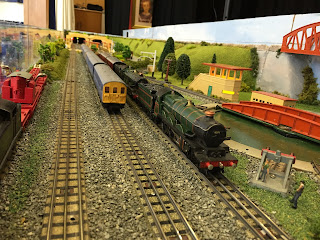As we prepare for another weekend exhibition (Weymouth this time - our home club) there were a few minor niggles that I wanted to resolve...
First of all the control panel. It's been rebuilt and re-overlayed a coupled of times during the 12 months of operation and during the last rebuild, I used self-adhesive photo paper which was then sprayed with lacquer. The gloss lacquer has a tendency to react with the paper and then lose adhesion, with the paper starting to bubble and lift quite badly, especially if stored in cold or slightly damp conditions. Even one night in the car is enough to lift most of the artwork.
As we've also made changes at the front of the layout removing points and adding the uncoupler, I decided to make changes to the graphics to reflect the new, simplified layout.
Thankfully all of the graphics files are stored safely for just this kind of situation but to actually replace the graphics requires not only removing the panel from the casing but also removal of the four ammeters and all of the switches.
After carefully removing everything I printed the new panel graphics, this time onto self-adhesive vinyl, which is much more forgiving. A couple of coats of matt lacquer seals the inkjet ink and prevents smudging.
This panel is actually made up of four individual pieces of vinyl:
With everything dried it was time to refit all the bits I'd removed. I also took the liberty of adding the logo, which was missed from the last panel:
The panel now re-assembled ready for the weekend:
Time for one other "small" project...
When I first completed the blue EMU project, I wanted to keep a genuine green set but found that in the current setup, I don't have sufficient room on the outer sidings to store it. Running as a nine car formation with the other set tends to detract from it somewhat, so I either need to sell it or find another use.
I'm not keen on selling it as it is a genuine example. When first built, the shuttle was designed to take EMUs in the form of the two Bachmann EPB units, however it was clear that due to the control equipment used at the time, they were difficult to control properly and invariably ended up skidding into the buffers. After changing to steam locos and later upgrading to feedback controllers, I then ended up moving the isolating diodes further to the buffers as the speed was much more realistic and controllable. This put an end to ever using the Bachmann units again as the pickup assembly is mounted on the inner bogie of the motor car - much the same as the Dublo EMU.
The only way to make the Dublo EMU work on the shuttle would be to move the pickup assembly to the outer bogie. First of all there isn't enough room under the motor bogie to mount the pickup, so a more radical approach was required - turn the chassis around!
Now again this sounds simple, but it really isn't and is not a modification to be recommended, particuarly if the unit is in mint condition, which thankfully mine isn't, although I really can't stomach the thought of making another blue EMU at the moment!
To complete this modification I stripped the motor coach completely. The coach body has a rectangular section of metalwork cut away above the motor bogie to accommodate the support beam that holds the motor in position, so first job was to cut an identical rectangular hole at the other end. For this I used the plastic inner sleeve that makes up the window glass as this also has the rectangular hole. I simply turned it the other way and marked the hole with a pen before cutting with a Dremel cutting disc.
With the hole cut into the coach body, I needed to remove another fixing strut, this will weaken the body slightly but shouldn't affect the performance of the unit. I also found that the centre fixing hole isn't entirely centre, it's about 2mm offset, so some slight reaming to the unpowered end of the coach frame was required to enable the unpowered bogie to rotate.
Finally everything was reassembled and the unit given a quick test around the loft track - all appears to be well so hopefully this will work well on the shuttle and provide a bit more variety!
Don't try this at home...













































